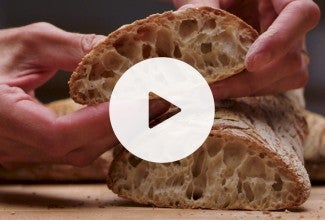Rustic Italian Ciabatta
This rustic Italian loaf is filled with irregular holes, all the better to trap a drizzle of olive oil. Cut lengthwise, ciabatta makes a wonderful Italian-style sandwich.



This rustic Italian loaf is filled with irregular holes, all the better to trap a drizzle of olive oil. Cut lengthwise, ciabatta makes a wonderful Italian-style sandwich.



To make the biga: Weigh your flour; or measure it by gently spooning it into a cup, then sweeping off any excess. Stir the water, flour, and yeast together, cover, and let rest at room temperature for 12 to 16 hours.
To make the dough: Add the water to the biga, mixing to incorporate the two. Combine the flour, yeast, and salt in a separate bowl, and add to the biga-water mixture. Mix on low speed of a stand mixer fitted with a dough hook until the dough becomes cohesive, about 2 minutes. Increase the mixer to medium speed and knead to form an elastic, sticky dough, about 3 to 4 minutes. Resist the urge to add more flour unless the dough is truly "soupy."
Cover the dough in the bowl, let it rise for 1 hour, then perform a bowl fold. To do a bowl fold, use your wet hand to grab a section of dough from one side, lift it up, then press it down firmly into the middle. Repeat this eight to 12 times.
Let the dough rise for another hour, then turn it out onto a liberally floured work surface, and sprinkle lots of flour on top.
Gently stretch the dough to an 8" x 10" rectangle and cut it into two pieces, each 4" x 10".
Transfer the loaves onto a piece of parchment or linen coated with flour, leaving about 6" between them. Cover with a lightly greased piece of plastic wrap or a freestanding plastic cover, and let rise until the loaves have expanded, and look puffy, about 1 to 2 hours depending on the temperature of your kitchen. The loaves are ready for the oven when an indent made with your fingertip stays visible for a few seconds and fills is very slowly; if it springs back, the loaves need more time.
About 30 minutes before the loaves are ready to bake, preheat the oven to 500°F. If you have a baking stone, place it in the middle of the oven when you start preheating, so it gets nice and hot.
Spritz the dough with water; or add steam to your oven (see "tips," below). If you're baking on a stone, transfer the bread to the stone, parchment and all. If you're using a pan, transfer the loaves on their parchment to a baking sheet, and place them on a middle rack of the oven. Lower the oven temperature to 425°F.
Bake the ciabatta until it's golden brown, approximately 22 to 25 minutes. Turn the oven off, place ciabatta on the oven's middle rack (remove the stone if you’ve used one), crack the door open about 2", and allow ciabatta to cool completely in the turned-off oven.
Fresh ciabatta is best enjoyed within a couple of days. For longer storage, wrap well and freeze.
For extra-crusty crust and the best rise, add steam to your oven as follows: While the oven is preheating, place an empty cast iron frying pan on the oven rack below the stone. If possible, adjust stone and pan so that the pan isn't directly under the stone, making it easier for steam to reach the baking bread. Once you’ve placed the bread in the oven, pour about 1 cup of boiling water into the cast iron frying pan. Steam will billow from the pan upwards to envelop the baking bread; be sure to wear good oven mitts to shield your hands and arms. Quickly close the oven door to trap the steam.
Join King Arthur baker Martin Philip and his family as they bake Rustic Italian Ciabatta together, start to finish. Watch Martin Bakes at Home — Ciabatta now.
The maximum temperature rating for most parchment paper is below 500°F, and at temperatures between 450°F and 500°F parchment’s exposed edges begin to char. To be safe, keep a close eye on anything being cooked at temperatures above 450°F (especially anything on an upper rack). Burned edges can also be minimized by trimming away excess parchment before baking.


